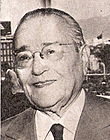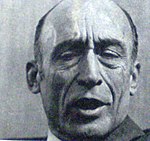Argentine general election, March 1973
|
|
|||||||||||||||||||||||||||||
|---|---|---|---|---|---|---|---|---|---|---|---|---|---|---|---|---|---|---|---|---|---|---|---|---|---|---|---|---|---|
|
|||||||||||||||||||||||||||||
|
|||||||||||||||||||||||||||||
|
|||||||||||||||||||||||||||||
Alejandro Lanusse
none (de facto regime)
Héctor Cámpora
Justicialist Party
The first Argentine general election of 1973 was held on 11 March. Voters chose both the President and their legislators and with a turnout of 85.5%, it produced the following results:
Note: The FREJULI ticket was declared the winner, bypassing the Electoral College.
The 1966 coup d'état against the moderate President Arturo Illia was carried out largely as a reaction to Illia's decision to honor local and legislative elections in which Peronists, officially banned from political activity following the violent overthrow of President Juan Perón in 1955, did well in. Five years later, however, President Alejandro Lanusse found himself heading an unpopular junta, saddled by increasing political violence and an economic wind-down from the prosperous 1960s. Seizing the initiative, he gathered leaders from across the nation's political and intellectual spectrum for a July 1971 asado, a time-honored Argentine custom as much about camaraderie as about steak.
The result was Lanusse's "Great National Agreement," a road map to the return to democratic rule, including Peronists (the first such concession the military had made since Perón's 1955 exile). The agreement, however, bore little resemblance to what had been discussed and, instead, proposed virtual veto power for the armed forces over most future domestic and foreign policy. This patently unacceptable condition led most political figures to dismiss the much-touted event as the "Great National Asado," instead.
A year later, President Lanusse made the much-anticipated announcement: elections would be held, nationally, on March 11, 1973. Retaliating for Perón's unequivocal rejection of the 1971 accords, Lanusse limited the field of candidates to those residing in Argentina as of August 25, 1972 - a clear denial of the aging Perón the right to run on his own party's ticket (the likely winners). Perón did return to Argentina, however, on November 17, when, during a month-long stay, he secured the endorsement of prominent figures such as former President Arturo Frondizi of the Integration and Development Movement, Jorge Abelardo Ramos of the Popular Leftist Front (FIP), Alberto Fonrouge, Christian Democrat Carlos Imbaud, and other, mainly provincial parties. These diverse parties signed on to an umbrella ticket, led by the Justicialist Party and Perón's personal representative in Argentina, Héctor Cámpora. Partly in recognition for their support and to provide a counter-weight to the left-leaning Cámpora, Perón had the Justicialist Liberation Front (FREJULI) nominate for Vice President Popular Conservative leader Vicente Solano Lima, a newspaper publisher respected across most of Argentina's vastly diverse political spectrum.
...
Wikipedia



